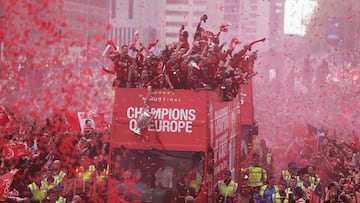SOCCER
Why are Liverpool nicknamed the Reds?
Both Liverpool and Man City, the Reds’ opponents on Sunday, have nicknames whose provenance doesn’t require the greatest of intellectual efforts to grasp.

When Liverpool take on Manchester City in the crunchest of top-of-the-table Premier League clashes on Sunday, it’ll be the Reds versus the Sky Blues - and in neither case is deep insight required to understand where the club’s nickname came from.
Elsewhere in the Premier League, you’ll find monikers with a bit more of a backstory - look no further than Liverpool’s merseyside rivals Everton, who are known as the Toffees (the sweet was traditionally sold outside the club’s stadium). There are also plenty of curious examples lower down the English league pyramid, such as Championship club West Bromwich Albion, who are nicknamed the Baggies (nope, nothing to do with baggy shorts, despite what you sometimes hear; there’s actually a long-ish explanation to that one).
As for Liverpool and City, they’re nicknamed as they are because well, it’s the colour they play in.
Liverpool haven’t always been the Reds
However, while Liverpool have now become synonymous with their famous all-red kit, they have in fact only worn it for less than half of their history. Indeed, if you travelled back in time to the immediate aftermath of the club’s founding, in 1892, you’d find yourself rather more inclined to call them the Blue and Whites.
Established by then-Anfield owner John Houlding, after original stadium occupants Everton upped sticks over a rent dispute, Liverpool played in blue and white halves for the first two years of their existence. The kit was essentially identical to one Everton had previously sported - and blue has, of course, become the colour most readily associated with Liverpool’s city rivals.
In 1894, Houlding then changed Liverpool’s shirt to red, in line with the city’s colours, paving the way for the club’s by now familiar, if hardly imaginative, identity as the Reds. However, it wasn’t until seven decades later that they began to play in red from head to toe. In the intervening years, the team wore various combinations - red shirt, white shorts and red socks; red shirt, white shorts and white shorts; and even a Manchester United-esque red shirt, white shorts and black socks - before Bill Shankly, the legendary Liverpool manager, intervened in November 1964.
“Christ, the players looked like giants”
As the club prepared to play what was only their second ever continental game at Anfield, a European Cup first-round first leg against Belgian champions Anderlecht, Shankly ordered captain Ron Yeats to try out a potential new look. Liverpool great Ian St John, who played for the Reds throughout the 1960s, recalled in his autobiography: “Shankly thought the colour scheme would carry psychological impact - red for danger, red for power. He came into the dressing room one day and threw a pair of red shorts to Ronnie Yeats. ‘Get into those shorts and let’s see how you look,’ he said. ‘Christ, Ronnie, you look awesome, terrifying. You look 7ft tall.’”
“The introduction of the all-red strip had a huge psychological effect […],” Shankly later said. “Christ, the players looked like giants. And we played like giants.” St John was among the scorers in a 3-0 thumping of Anderlecht - who were beaten 4-0 on aggregate - and an iconic kit was born.






